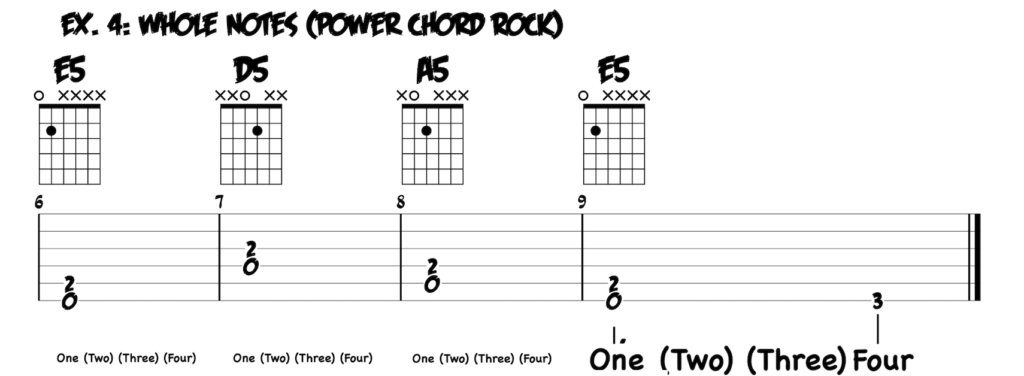
Every aspiring rock guitarist needs to understand the core rhythms that drive the music they love. The “Basic Rhythms” sheet by Brian Parham from Rock Dojo offers an excellent introduction to these essential beats. Let’s break down each rhythmic value using the specific examples provided:

Quarter Notes: Your Guitar Rhythms Foundation – ‘Frosty Ice Cream’
Example 1 on the sheet is all about quarter notes, each holding the line for a single beat. Think of them as the pulse of the music, a steady heartbeat that keeps the rhythm on track. In “Frosty Ice Cream,” we strum down once per beat on open strings and fretted notes alike, learning to keep our timing consistent. For instance, the sheet shows us playing an open A string, then the third fret, the fifth fret, and back, all in a 4/4 time signature, which means we play four quarter notes per measure. This is fundamental for a rock rhythm guitarist, as most rock songs are built around the unwavering tempo of quarter notes.

Eighth Notes: Quickening Your Guitar Rhythms – ‘Peter Gunn Theme’
Example 2 introduces eighth notes, which slice the beat in half, creating a “1 and 2 and 3 and 4 and” count. In the “Peter Gunn Theme,” we alternate between downstrokes on the numbers and upstrokes on the “ands,” doubling the amount of strums within the same 4/4 time. On the sheet, you’ll see this pattern played across different frets, starting with an open string and moving up the fretboard. This exercise trains the player to handle a faster strumming pace, crucial for injecting energy into a song.

Half Notes: Deepening Your Guitar Rhythms – ‘Electric Funeral’
The third example shifts focus to half notes, which stretch out for two beats each, giving a sense of breadth and weight to the rhythm. In “Electric Funeral,” the sheet music illustrates how letting chords ring out over multiple beats can add a dramatic effect to the music. For instance, a half note on the second fret of the A string held for two beats before moving on to the next note teaches the guitarist about sustain and space within a measure.

Whole Notes: Expanding Guitar Rhythms – ‘Power Chord Rock’
Finally, Example 4 on the sheet brings us to whole notes. Each whole note encompasses an entire four-beat measure, allowing the note or chord to fully resonate. “Power Chord Rock” features whole notes played as power chords—an iconic element in rock music—where the guitarist strums once and lets the chord sound through the entire measure. This practice is pivotal for creating moments of impact within a song, allowing the guitar to fill the musical space with its rich, full-bodied tone.
Strum Towards Mastery
Understanding and practicing these basic rhythms using the examples provided will give any beginner guitarist a solid rhythmic foundation. From the single beat of a quarter note to the expansive four beats of a whole note, each has its place in the tapestry of rock music. With these skills, you can strum along confidently, knowing you’re building the essential rhythms that have propelled countless songs through the history of rock.
Sample Video: 5 Must Know Strum Patterns for Guitar
Once you understand these primary rhythms, you can use them to play songs, create riffs, and strum along to your favorite songs. In this video from the Rock Dojo Complete Series, you’ll expand on your newfound knowledge of primary rhythms to learn five must-know strum patterns for guitar.
Unleash Your Child’s Guitar Skills!
Explore the exciting world of online guitar lessons for kids with Rock Dojo’s Complete Series. Our comprehensive program teaches essential guitar rhythms and beyond, tailored for convenience and affordability at just $249. Ensure your child’s musical journey thrives—enroll today to keep the rhythm going strong with Rock Dojo. Elevate their musical talents with each note they play!


